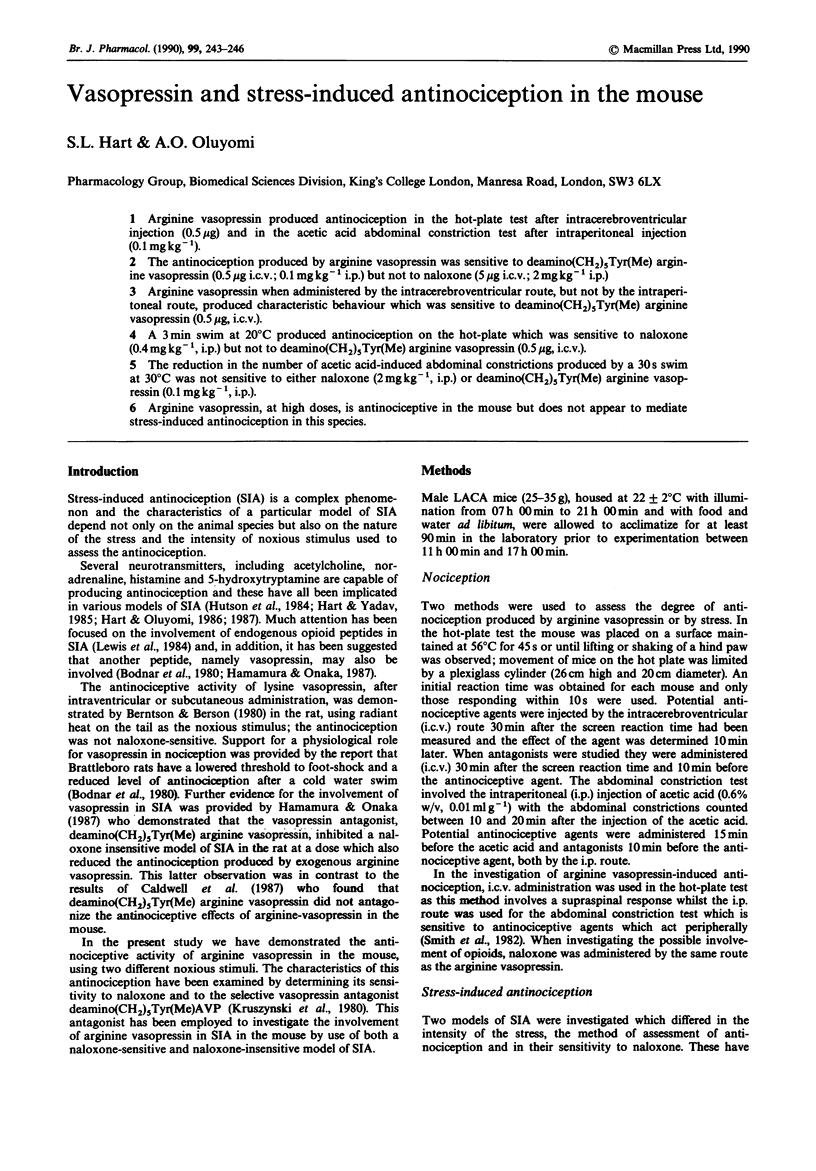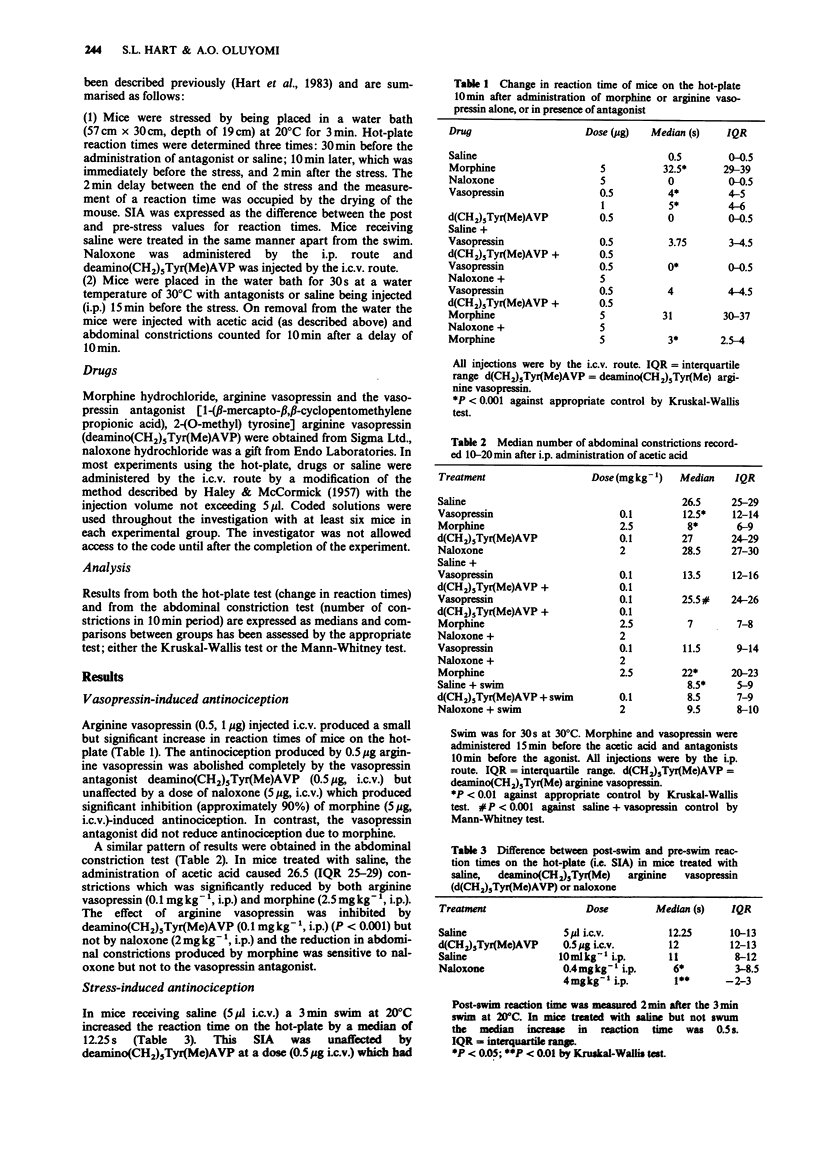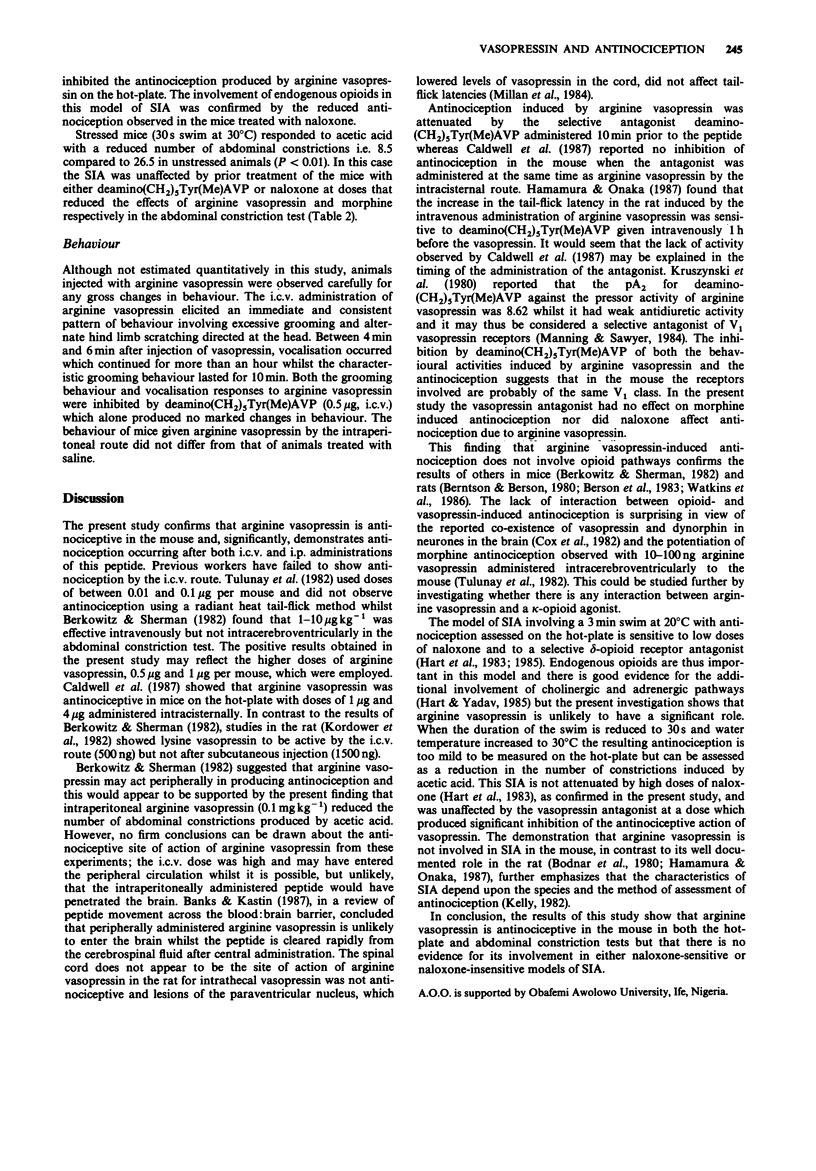Abstract
1. Arginine vasopressin produced antinociception in the hot-plate test after intracerebroventricular injection (0.5 micrograms) and in the acetic acid abdominal constriction test after intraperitoneal injection (0.1 mg kg-1). 2. The antinociception produced by arginine vasopressin was sensitive to deamino(CH2)5Tyr(Me) arginine vasopressin (0.5 micrograms i.c.v.; 0.1 mg kg-1 i.p.) but not to naloxone (5 micrograms i.c.v.; 2 mg kg-1 i.p.) 3. Arginine vasopressin when administered by the intracerebroventricular route, but not by the intraperitoneal route, produced characteristic behaviour which was sensitive to deamino(CH2)5Tyr(Me) arginine vasopressin (0.5 micrograms, i.c.v.). 4. A 3 min swim at 20 degrees C produced antinociception on the hot-plate which was sensitive to naloxone (0.4 mg kg-1, i.p.) but not to deamino(CH2)5Tyr(Me) arginine vasopressin (0.5 micrograms, i.c.v.). 5. The reduction in the number of acetic acid-induced abdominal constrictions produced by a 30 s swim at 30 degrees C was not sensitive to either naloxone (2 mg kg-1, i.p.) or deamino(CH2)5Tyr(Me) arginine vasopressin (0.1 mg kg-1, i.p.). 6. Arginine vasopressin, at high doses, is antinociceptive in the mouse but does not appear to mediate stress-induced antinociception in this species.
Full text
PDF



Selected References
These references are in PubMed. This may not be the complete list of references from this article.
- Banks W. A., Kastin A. J. Saturable transport of peptides across the blood-brain barrier. Life Sci. 1987 Sep 14;41(11):1319–1338. doi: 10.1016/0024-3205(87)90606-0. [DOI] [PubMed] [Google Scholar]
- Berkowitz B. A., Sherman S. Characterization of vasopressin analgesia. J Pharmacol Exp Ther. 1982 Feb;220(2):329–334. [PubMed] [Google Scholar]
- Berntson G. G., Berson B. S. Antinociceptive effects of intraventricular or systemic administration of vasopressin in the rat. Life Sci. 1980 Feb 11;26(6):455–459. doi: 10.1016/0024-3205(80)90165-4. [DOI] [PubMed] [Google Scholar]
- Berson B. S., Berntson G. G., Zipf W., Torello M. W., Kirk W. T. Vasopressin-induced antinociception: an investigation into its physiological and hormonal basis. Endocrinology. 1983 Jul;113(1):337–343. doi: 10.1210/endo-113-1-337. [DOI] [PubMed] [Google Scholar]
- Bodnar R. J., Zimmerman E. A., Nilaver G., Mansour A., Thomas L. W., Kelly D. D., Glusman M. Dissociation of cold-water swim and morphine analgesia in Brattleboro rats with diabetes insipidus. Life Sci. 1980 May 12;26(19):1581–1590. doi: 10.1016/0024-3205(80)90361-6. [DOI] [PubMed] [Google Scholar]
- Caldwell J. D., Mason G. A., Stanley D. A., Jerdack G., Hruby V. J., Hill P., Prange A. J., Jr, Pedersen C. A. Effects of nonapeptide antagonists on oxytocin- and arginine-vasopressin-induced analgesia in mice. Regul Pept. 1987 Aug 17;18(3-4):233–241. doi: 10.1016/0167-0115(87)90011-5. [DOI] [PubMed] [Google Scholar]
- Cox B. M., Baer E. R., Goldstein A. Dynorphin immunoreactivity in pituitary. Adv Biochem Psychopharmacol. 1982;33:43–50. [PubMed] [Google Scholar]
- HALEY T. J., MCCORMICK W. G. Pharmacological effects produced by intracerebral injection of drugs in the conscious mouse. Br J Pharmacol Chemother. 1957 Mar;12(1):12–15. doi: 10.1111/j.1476-5381.1957.tb01354.x. [DOI] [PMC free article] [PubMed] [Google Scholar]
- Hart S. L., Slusarczyk H., Smith T. W. The effects of selective opioid delta-receptor antagonists on stress-induced antinociception and plasma corticosterone levels in mice. Neuropeptides. 1985 Feb;5(4-6):303–306. doi: 10.1016/0143-4179(85)90013-7. [DOI] [PubMed] [Google Scholar]
- Hart S. L., Slusarczyk H., Smith T. W. The involvement of opioid delta-receptors in stress induced antinociception in mice. Eur J Pharmacol. 1983 Nov 25;95(3-4):283–285. doi: 10.1016/0014-2999(83)90647-7. [DOI] [PubMed] [Google Scholar]
- Kelly D. D. The role of endorphins in stress-induced analgesia. Ann N Y Acad Sci. 1982;398:260–271. doi: 10.1111/j.1749-6632.1982.tb39499.x. [DOI] [PubMed] [Google Scholar]
- Kordower J. H., Sikorszky V., Bodnar R. J. Central antinociceptive effects of lysine-vasopressin and an analogue. Peptides. 1982 Jul-Aug;3(4):613–617. doi: 10.1016/0196-9781(82)90159-0. [DOI] [PubMed] [Google Scholar]
- Kruszynski M., Lammek B., Manning M., Seto J., Haldar J., Sawyer W. H. [1-beta-Mercapto-beta,beta-cyclopentamethylenepropionic acid),2-(O-methyl)tyrosine ]argine-vasopressin and [1-beta-mercapto-beta,beta-cyclopentamethylenepropionic acid)]argine-vasopressine, two highly potent antagonists of the vasopressor response to arginine-vasopressin. J Med Chem. 1980 Apr;23(4):364–368. doi: 10.1021/jm00178a003. [DOI] [PubMed] [Google Scholar]
- Millan M. J., Schmauss C., Millan M. H., Herz A. Vasopressin and oxytocin in the rat spinal cord: analysis of their role in the control of nociception. Brain Res. 1984 Sep 10;309(2):384–388. doi: 10.1016/0006-8993(84)90610-3. [DOI] [PubMed] [Google Scholar]
- Smith T. W., Buchan P., Parsons D. N., Wilkinson S. Peripheral antinociceptive effects of N-methyl morphine. Life Sci. 1982 Sep 20;31(12-13):1205–1208. doi: 10.1016/0024-3205(82)90343-5. [DOI] [PubMed] [Google Scholar]
- Tulunay F. C., Jen M. F., Loh H. H. Possible physiological control of morphine analgesia in mice. Eur J Pharmacol. 1982 Sep 24;83(3-4):317–319. doi: 10.1016/0014-2999(82)90269-2. [DOI] [PubMed] [Google Scholar]
- Watkins L. R., Suberg S. N., Thurston C. L., Culhane E. S. Role of spinal cord neuropeptides in pain sensitivity and analgesia: thyrotropin releasing hormone and vasopressin. Brain Res. 1986 Jan 8;362(2):308–317. doi: 10.1016/0006-8993(86)90455-5. [DOI] [PubMed] [Google Scholar]


